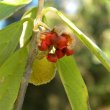Kiggelaria africana
| Botanical Name | Kiggelaria africana |
|||||||||||
| Family | Flacourtiaceae - The governers-plum family. |
|||||||||||
| Pronunciation | kig-ga-LAIR-ree-uh af-ri-KAHN-uh |
|||||||||||
| Common Name(s) |
English: Wild peach; Natal Mahogany; Red Ebony
Afrikaans: Wildeperske; Kershout; Witstinkhout
IsiXhosa: umKokoko; Umhlizinyathi; Umvethi
IsiZulu: uMunwe
Sesotho sa Leboa: Monêpênêpê
Sesotho: Lekgatsi
Tshivenda: Muphatavhafu
|
|||||||||||
| Plant Group |
|
|||||||||||
| Plant Size |
|
|||||||||||
| Position |
|
|||||||||||
| General Information |
|
|||||||||||
| Specific Information | Despite its common name, Kiggelaria africana is not related to the fruit-producing Peach tree. The leaves are superficially similar but are thicker, stiffer, and have a thin coating of fur on the undersides. Kiggelaria has a tendency to branch low down, making it useful as a screen or windbreak. Prune the lower branches while young if you wish to create a tree shape. This species needs male and female trees to pollinate the flowers. The fruits are round capsules which split open to reveal the seeds which are each covered in a layer of bright orange-red flesh, drawing many wild birds to the feast. The caterpillars of a number of butterfly species sometimes eat the tree bare, but this is part of a natural process, adding insect eating bird visitors, and the trees rapidly regrow their foliage. Young trees start flowering after a year or two. Kiggelaria africana grows in both summer and winter rainfall areas and varies in size from a scrubby bush in the Karoo to over 20 meters high in a forest. Can you help? I am in need of more pictures of this species. If you have any that you are prepared to let me use, please contact me. Source will be acknowledged. |
|||||||||||
| Ad Break | ||||||||||||
| Flowers | ||||||||||||
| Description | tiny, bell-shaped flowers |
|||||||||||
| Season |
|
|||||||||||
| Colour |
|
|||||||||||
| Growth Rate |
|
|||||||||||
| Plant Uses |
|
|||||||||||
| Distribution and Habitat | found in all provinces of South Africa and north to Kenya, in coastal and inland forests, along streams, in bushveld and woodlands, and on rocky hillsides |
|||||||||||
| Planting Suggestions | Kiggelaria africana prefers full sun but will tolerate some shade. Water moderately, at least while young, to encourage quick growth. The old method of digging a deep hole and filling it with soil and compost has resulted in many trees failing to thrive, dying, rotting at the base or worse still, falling over in later years due to poor root development. Refer to the following sites for the best method of planting trees: International Society of Arboriculture: New Tree Planting Tree People: Plant the right way For those of you who have a clay problem try: |
|||||||||||
| Medicinal Uses | The wood is a useful general purpose timber for beams, floorboards and furniture. It was used in the past for the spokes of wagon wheels. While the South Sotho prepare a potion from the wild peach to protect their kraals from lightning, there is a belief among Tembu people that this tree will attract lightning. |
|||||||||||
| Ad Break | ||||||||||||





Comments
Pics of Kiggelaria
Hi Lorraine
Here are some pics as you requested.
As you can see mine is the smooth leaved one, although the caterpillars were chewing them so I had to search for ones that weren't too bad.
I added some pics of the caterpillars also, I don't know their name but they only eat this plant and are lovely little orange butterflies later. They don't do much harm and the plant has grown nicely
My Mom has the other plant with the slimmer serrated leaves
I will try to get some pics of hers but it is in a difficult position to photograph
Hope this is helpful
Liza
ps won't let me send pics
says they are large?
will try to email them to you
let me know if you don't get them if you still want them
Thanx
Pics of Kiggelaria
I would like to send pics of my tree but they are 5MB each and I don't know how to make them smaller. Do you have an email I can send them to?
Pictures
Hi Lisa
Thank you, yes. I definitely would like to get the pics. My email is: kumbulanursery@gmail.com. I suggest you 'zip' the pictures as this will reduce the up- and down-loading time. If you are not sure how to zip, email me so I can give you my phone number and I'll walk you through it.
Warm regards
Lorraine
Discuss this plant
Share knowledge, ask a question or give an experience.